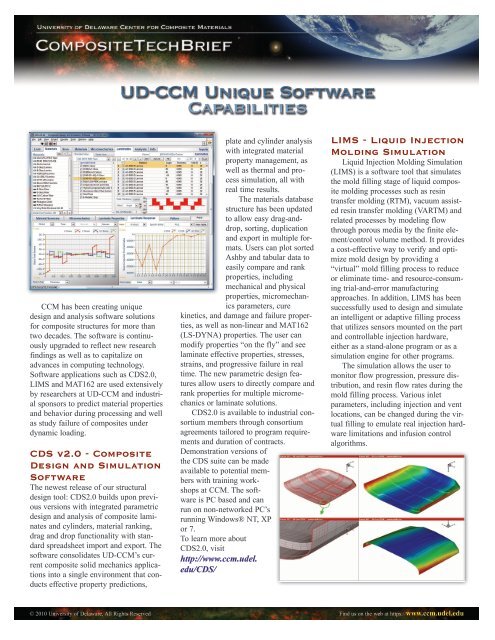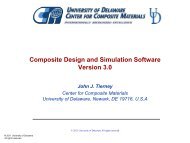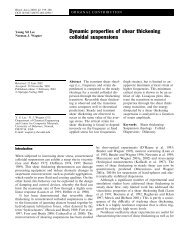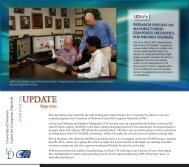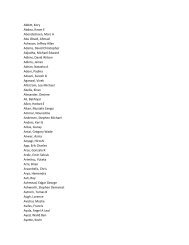CDS v2.0 - Composite Design and Simulation Software LIMS ...
CDS v2.0 - Composite Design and Simulation Software LIMS ...
CDS v2.0 - Composite Design and Simulation Software LIMS ...
Create successful ePaper yourself
Turn your PDF publications into a flip-book with our unique Google optimized e-Paper software.
CCM has been creating unique<br />
design <strong>and</strong> analysis software solutions<br />
for composite structures for more than<br />
two decades. The software is continuously<br />
upgraded to reflect new research<br />
findings as well as to capitalize on<br />
advances in computing technology.<br />
<strong>Software</strong> applications such as <strong>CDS</strong>2.0,<br />
<strong>LIMS</strong> <strong>and</strong> MAT162 are used extensively<br />
by researchers at UD-CCM <strong>and</strong> industrial<br />
sponsors to predict material properties<br />
<strong>and</strong> behavior during processing <strong>and</strong> well<br />
as study failure of composites under<br />
dynamic loading.<br />
<strong>CDS</strong> <strong>v2.0</strong> - <strong>Composite</strong><br />
<strong>Design</strong> <strong>and</strong> <strong>Simulation</strong><br />
<strong>Software</strong><br />
The newest release of our structural<br />
design tool: <strong>CDS</strong>2.0 builds upon previous<br />
versions with integrated parametric<br />
design <strong>and</strong> analysis of composite laminates<br />
<strong>and</strong> cylinders, material ranking,<br />
drag <strong>and</strong> drop functionality with st<strong>and</strong>ard<br />
spreadsheet import <strong>and</strong> export. The<br />
software consolidates UD-CCM’s current<br />
composite solid mechanics applications<br />
into a single environment that conducts<br />
effective property predictions,<br />
plate <strong>and</strong> cylinder analysis<br />
with integrated material<br />
property management, as<br />
well as thermal <strong>and</strong> process<br />
simulation, all with<br />
real time results.<br />
The materials database<br />
structure has been updated<br />
to allow easy drag-<strong>and</strong>drop,<br />
sorting, duplication<br />
<strong>and</strong> export in multiple formats.<br />
Users can plot sorted<br />
Ashby <strong>and</strong> tabular data to<br />
easily compare <strong>and</strong> rank<br />
properties, including<br />
mechanical <strong>and</strong> physical<br />
properties, micromechanics<br />
parameters, cure<br />
kinetics, <strong>and</strong> damage <strong>and</strong> failure properties,<br />
as well as non-linear <strong>and</strong> MAT162<br />
(LS-DYNA) properties. The user can<br />
modify properties “on the fly” <strong>and</strong> see<br />
laminate effective properties, stresses,<br />
strains, <strong>and</strong> progressive failure in real<br />
time. The new parametric design features<br />
allow users to directly compare <strong>and</strong><br />
rank properties for multiple micromechanics<br />
or laminate solutions.<br />
<strong>CDS</strong>2.0 is available to industrial consortium<br />
members through consortium<br />
agreements tailored to program requirements<br />
<strong>and</strong> duration of contracts.<br />
Demonstration versions of<br />
the <strong>CDS</strong> suite can be made<br />
available to potential members<br />
with training workshops<br />
at CCM. The software<br />
is PC based <strong>and</strong> can<br />
run on non-networked PC’s<br />
running Windows® NT, XP<br />
or 7.<br />
To learn more about<br />
<strong>CDS</strong>2.0, visit<br />
http://www.ccm.udel.<br />
edu/<strong>CDS</strong>/<br />
<strong>LIMS</strong> - Liquid Injection<br />
Molding <strong>Simulation</strong><br />
Liquid Injection Molding <strong>Simulation</strong><br />
(<strong>LIMS</strong>) is a software tool that simulates<br />
the mold filling stage of liquid composite<br />
molding processes such as resin<br />
transfer molding (RTM), vacuum assisted<br />
resin transfer molding (VARTM) <strong>and</strong><br />
related processes by modeling flow<br />
through porous media by the finite element/control<br />
volume method. It provides<br />
a cost-effective way to verify <strong>and</strong> optimize<br />
mold design by providing a<br />
“virtual” mold filling process to reduce<br />
or eliminate time- <strong>and</strong> resource-consuming<br />
trial-<strong>and</strong>-error manufacturing<br />
approaches. In addition, <strong>LIMS</strong> has been<br />
successfully used to design <strong>and</strong> simulate<br />
an intelligent or adaptive filling process<br />
that utilizes sensors mounted on the part<br />
<strong>and</strong> controllable injection hardware,<br />
either as a st<strong>and</strong>-alone program or as a<br />
simulation engine for other programs.<br />
The simulation allows the user to<br />
monitor flow progression, pressure distribution,<br />
<strong>and</strong> resin flow rates during the<br />
mold filling process. Various inlet<br />
parameters, including injection <strong>and</strong> vent<br />
locations, can be changed during the virtual<br />
filling to emulate real injection hardware<br />
limitations <strong>and</strong> infusion control<br />
algorithms.<br />
© 2010 University of Delaware, All Rights Reserved Find us on the web at https://www.ccm.udel.edu
Center for <strong>Composite</strong> Materials | 201 <strong>Composite</strong>s Manufacturing Science Lab | University of Delaware | Newark, DE 19716-3144<br />
A number of other effects, such as racetracking--the<br />
tendency for resin to flow<br />
much faster around corners—<strong>and</strong> placement<br />
of the distribution media in<br />
VARTM type processes can be easily<br />
modeled via a user-friendly graphical<br />
interface called LimsUI. By point <strong>and</strong><br />
click, LimsUI allows the user to effortlessly<br />
modify the material <strong>and</strong> injection<br />
parameters, run simulations, view the<br />
simulation results, create racetracking<br />
channels <strong>and</strong> distribution media layers,<br />
<strong>and</strong> change or add injection <strong>and</strong> vent<br />
locations.<br />
<strong>LIMS</strong> also has a built-in scripting<br />
which allows the user to tailor the simulation<br />
to address many special issues.<br />
Scripts can access the parameters during<br />
the simulation <strong>and</strong> modify them as<br />
needed. It is even possible to modify the<br />
material data during the simulation. This<br />
allows the user to simulate complex filling<br />
schemes such as those using adaptive<br />
controls. Finally, for those interested<br />
in utilizing the simulation engine in their<br />
own program--for example, for the purpose<br />
of optimization--there is a slave<br />
version <strong>and</strong> dynamically linkable library<br />
that can be included in the user program.<br />
Currently, <strong>LIMS</strong> is supported for the<br />
Windows XP (32- <strong>and</strong> 64-bit) environment<br />
<strong>and</strong> later, <strong>and</strong> the simulation<br />
engine ports for UNIX are also available.<br />
To learn more about <strong>LIMS</strong>, visit<br />
http://www.ccm.udel.edu/Pubs/techbriefs/<strong>LIMS</strong>.pdf<br />
MAT162 in LS-DYNA:<br />
Progressive Damage<br />
Modeling of<br />
<strong>Composite</strong>s<br />
In collaboration with Materials<br />
Sciences Corporation, CCM has developed<br />
a progressive composite damage<br />
model (pCDM) for uni-directional (UD)<br />
<strong>and</strong> plain-weave (PW) fabric composites,<br />
known as MAT162 <strong>and</strong> implemented<br />
in LS-DYNA. MAT162 is the stateof-the-art<br />
in three-dimensional high<br />
strain rate progressive damage modeling<br />
of UD <strong>and</strong> PW composites using solid<br />
elements <strong>and</strong> was developed on the<br />
foundation of earlier the orthotropic<br />
composite models MAT02 <strong>and</strong> MAT59.<br />
Based on Hashin's theory, five quadratic<br />
failure criteria for UD composites <strong>and</strong><br />
seven failure criteria for PW composites<br />
are defined to model different composite<br />
damage modes—for example, matrix<br />
cracking, delamination, fiber tensionshear,<br />
fiber compression, fiber shear, <strong>and</strong><br />
composite crush. MAT162 has the capability<br />
of modeling the post-damage softening<br />
behavior of composites as well as<br />
simulating the material degradation that<br />
occurs with various damage modes.<br />
MAT162 requires a series of softening<br />
<strong>and</strong> rate parameters in addition to<br />
elastic constants <strong>and</strong> strength properties.<br />
CCM has developed a series of model<br />
experiments to determine these parameters<br />
by conducting a series of parametric<br />
simulations of quasi-static punch shear,<br />
dynamic punch shear, <strong>and</strong> ballistic experiments.<br />
CCM is now developing pCDM<br />
for 2D <strong>and</strong> 3D fabric composites of various<br />
weaving architectures. In order to<br />
bridge the gap from micro- to meso- to<br />
macro-mechanics based damage model,<br />
CCM will incorporate different failure<br />
theories in different scales.<br />
MAT162 progressive damage is now<br />
available in explicit FEA code LS-Dyna;<br />
however, the codes are being implemented<br />
in ABAQUS for implicit <strong>and</strong> structural<br />
analysis.<br />
To learn more about MAT162, visit<br />
http://www.ccm.udel.edu/Tech/<br />
MAT162/Intro.htm<br />
Technical Contacts<br />
John Tierney<br />
<strong>CDS</strong><br />
Phone: 302.831.0548<br />
yarlagad@udel.edu<br />
Pavel Simacek<br />
<strong>LIMS</strong><br />
Phone: 302.831.6454<br />
psimacek@udel.edu<br />
Bazle Gama<br />
MAT 162<br />
Phone: 302.831.0248<br />
gama@udel.edu<br />
© 2010 University of Delaware, All Rights Reserved Fax: 302.831.8525 Find us on the web at http://www.ccm.udel.edu


